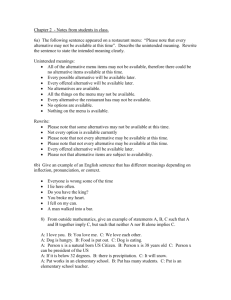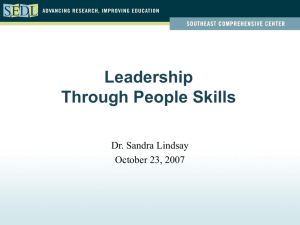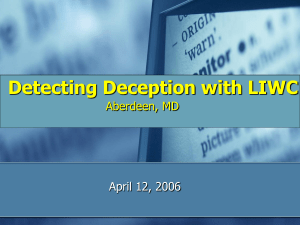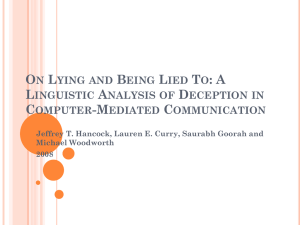Four Functions of Communication
advertisement
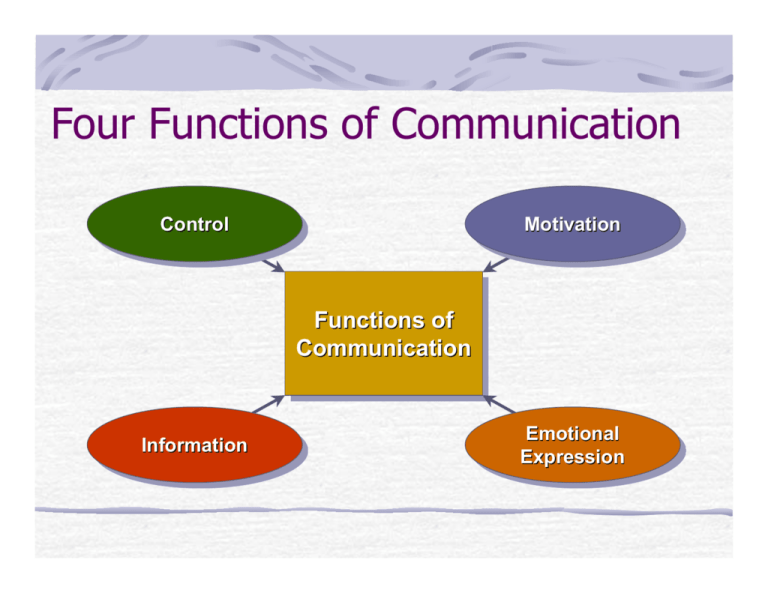
Four Functions of Communication Control Control Motivation Motivation Functions Functionsof of Communication Communication Information Information Emotional Emotional Expression Expression E-Mail Dos and Don’ts E-mail allows telecommuting employees to work from home and keep in contact. The use of e-mail is growing rapidly and e-mail etiquette is expected: Typing messages in all CAPITALS is seen as “screaming” at the receiver. Punctuate your messages for easy reading and don’t ramble on. Pay attention to spelling and treat the message like a written letter. Non-verbal hints for meetings 1. Lean slightly forward 2. Open hand gestures 3. 30-60% eye to eye contact. More – you will look mad, less you will look shifty or bored 4. Don’t sit defensively – hands across body, knees pressed together, hand over your mouth – it can look neurotic or unstable 5. Don’t fidget or play with your hair or grin maniacally 6. Don’t slouch in the chair, arms behind your head with a challenging stare Lie detectors - Verbal cues Response latency – liars take longer to respond, hesitate more Linguistic distance – Not saying “I”, but “one may believe” Low, uneven speech – Tries to think through their lies, might suddenly talk quickly, attempting to make a sensitive subject appear less significant An increase in stuttering and slurring – including Freudian slips Too eager to fill gaps in conversation – liars keep talking, silence indicates the other person doesn’t believe them Too many pitch raises – instead of the pitch dropping at the end of a reply, it is lifted in the same way as asking a question Reading People Up and to the Right - Indicates: Visually Remembered Images (Vr) If you asked someone to "What colour was your first car?", this would be the direction their eyes moved in while thinking about the question as they "Visually Remembered" the color of their first car. Powertalking strategies Positive talk – genuine commitments, high expectations, avoid conditional phrases, seek creative solutions, look for benefits Give credit – alter or ignore shortcomings, neither apologise or justify, praise others Learn from experience – “I learned”, not “I failed”, think positive when feeling low, focus on options rather than regrets Accept responsibility – admit feelings, accept responsibility, control use of time Guidelines for Active Listening Don’t try to change the other’s views. Don’t solve the problem for the speaker. Don’t give advice. Don’t pass judgment. Don’t explain or interpret others’ behavior. Don’t give false reassurances. Don’t attack if the speaker is hostile. Don’t ask “why” the feelings. Don’t jump to conclusions or evaluating the speaker’s remarks. Types of Questions Closed – “did you enjoy?” yes/no answers : establishes early conversational control. Closed questions are useful if only factual info is required. Open questions encourage discussion of irrelevant information, for which their may be no time. Interviewers used closed questions at the beginning of an interview to establish control Open – ”what did you think” - to introduce a subject, to encourage further discussion, to keep the other person talking. Probe – “can you tell me more about” – to follow up an open question, to get more information, to show interest. Another form of an open question How To Establish Rapport Dress properly Smile and maintain eye contact. Have a well-prepared opening statement designed to arouse interest and curiosity. Pay them a sincere compliment. Find common interests and get them to talk about them. Do not talk about your own problems. Use the customer’s name and use it often. Do not presume to address them by their first name. Ask for permission. Limit the use of the words “I” and “me”. Be enthusiastic and confident without being pushy or conceded or condescending. Always exercise good manners and never use bad language. Leave your bad habits behind. Lower power indicators Hedges and qualifiers – “maybe it has some strengths” Irritators – “you know”, “sort of”, “kinda” Intensifiers – “really”, “awfully”, “horrendously” Tags – “aren’t they”, “didn’t you” Hesitations – “um, er, ah, uhh, well” Excessive questions – signal and uncertainty and a need for attention Seven difficult personality types The most difficult personalities Super-agreeable and unresponsive people are the most difficult personalities to deal with because they don’t reveal their true selves or motives. Superagreeables have such a strong need to be liked that they will become whatever others need them to be at the expense of their own needs and wants. Unresponsive people may be the most difficult people to deal with, because they are hard to understand and are seemingly impossible to draw out. And that’s what must be done: Draw them out. Use open-ended questions that require them to volunteer more than a “Yes” or “No” answer. Asking unresponsive people to think about solutions, and to present them at a scheduled subsequent meeting is another way to draw them out. Ways people use to get in favour 1. 2. 3. 4. 5. 6. Ingratiation – Favours to the powerful, flattery, yes-man Intimidation – convey image of potential danger, veiled threats of exposure Self – promotion – embellish your accomplishments, overstate your abilities, display awards Exemplification – create impression of selfless dedication and self sacrifice, so those in power feel guilty Accounting – distance yourself from negative events, deny personal responsibility, diminish seriousness of difficulties Supplication – Get powerful people to be sympathetic and nurturing, for example, by eg requests for mentoring








